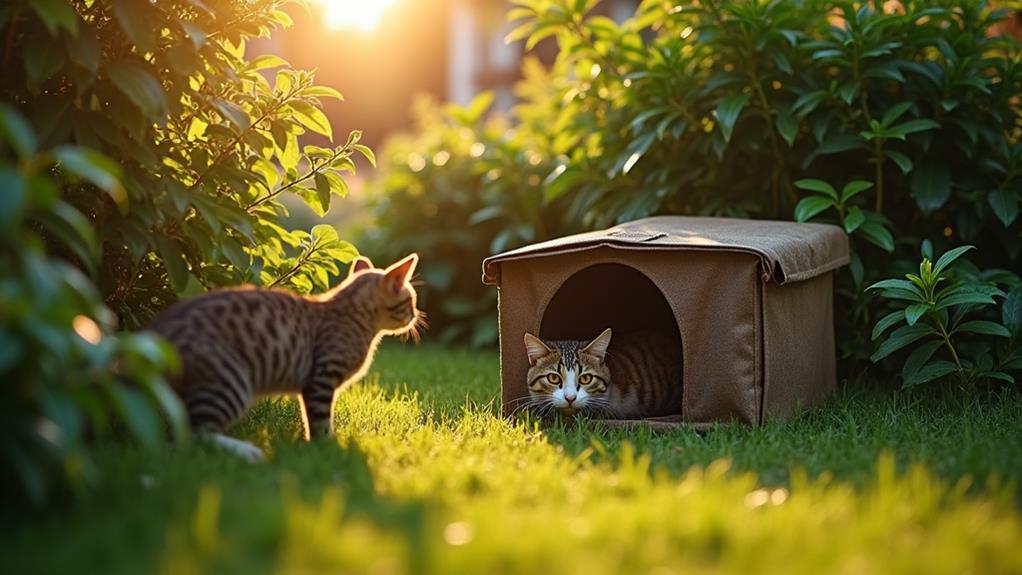How to Rescue a Feral Cat: A Guide to Safe and Humane Capture

To safely and humanely rescue a feral cat, start by recognizing their behavior patterns—feral cats avoid humans and are most active at night. Set up a feeding station at a consistent time and place. Avoid feeding the night before trapping to heighten hunger. Use strong-smelling bait like mackerel, and set traps at dusk. Once trapped, cover the cage to lower stress and place them in a sheltered holding area before any medical assessments. Make sure they're spayed or neutered before returning them to the original capture site. With these steps in mind, you're on the right path to successful rescue.
Understanding Feral Cat Behavior
Feral cats, unlike their stray counterparts, are typically un-socialized, often avoiding human contact and exhibiting nocturnal behaviors. You might notice them skirting the edges of your vision, active at night while hiding during the day. These cats have adapted to independent living, relying on their instincts rather than seeking human support. They often form community cat colonies around a reliable food source. Observing feral cats can reveal their complex social structures, which may include hierarchies and cooperative behaviors within the colony.
It's critical to confirm a cat's feral status by watching their interactions. True ferals will consistently avoid human contact and display wary, fearful behaviors. They won't approach you for food or interaction, highlighting their need for independence. Understanding this behavior is significant because feral cats might exhibit aggressive behavior when threatened, especially if trapped. That's why using humane traps is essential; they allow for safe capture without causing harm or distress to the cat.
Preparing for Safe Capture
Capturing a feral cat requires careful preparation to guarantee the process is as safe and stress-free as possible. Start by establishing a feeding station where you consistently provide food at the same location and time. This routine helps build trust and gets feral cats comfortable with the area, making them more likely to enter a trap when the time comes. TNR programs emphasize the significance of this step in ensuring humane capture.
The night before setting up the trap, refrain from feeding them so they'll be hungry and more inclined to investigate the bait. Use strong-smelling options like canned mackerel to lure them in effectively. Timing is essential, so plan to set traps at dusk, which aligns with their natural feeding habits.
Before capturing, prepare a sheltered holding area where the cats can stay before and after their spay and neuter clinic visit. This reduces stress and shields them from harsh weather. Ensuring they receive necessary medical attention is critical to their health and well-being. This preparation not only supports a successful capture but also guarantees a humane and effective contribution to TNR efforts by improving the lives of feral cats.
Setting Up Traps Effectively

Setting up traps effectively is vital for the humane capture of feral cats. Start by feeding the feral cats consistently at the same location and time. This routine helps them get familiar with the area, making them more likely to return regularly. The night before you plan to trap, avoid feeding them so they'll be hungry and more inclined to enter the traps. This strategy increases your chances of success when you set the traps.
It's best to set traps at dusk, aligning with the cats' natural feeding times. This timing helps guarantee that they're active and looking for food. Use strong-smelling bait like canned mackerel or warm chicken to lure them in. Such aromas are irresistible and can effectively attract feral cats in your area to the traps.
Once you've successfully trapped a cat, it's significant to cover traps immediately. Covering them helps minimize stress and keeps the captured cat calm, making the process more humane. By following these steps, you're not only setting up traps effectively but also safeguarding the welfare of the feral cats you aim to help. Remember, a calm cat is a safe cat.
Health Assessment and Care
Evaluating the health of a feral cat before capture is crucial to guarantee they're safe and ready for any necessary care. Start by observing the cat for signs of illness like lethargy, coughing, or visible injuries—these may need immediate veterinary attention after you've safely trapped the cat. Once captured, it's vital to monitor cats for common health issues such as respiratory infections or abscesses, often resulting from fights or environmental hazards.
When preparing for surgery, remember to withhold food from the cat to prevent complications during anesthesia. After the procedure, focus on post-surgery care by watching for signs of recovery. Look for alertness and normal behavior, and if you notice any complications, consult a veterinarian. This part of the process guarantees the humane capture and care of feral cats.
Regularly disinfect traps with bleach after each use to curb disease transmission in the cat population. Ensure traps are stored in a closed position to avoid accidental captures and starvation. By maintaining these practices, you can effectively and humanely care for feral cats while supporting their health and wellbeing.
Returning Cats to Their Habitat

Once you've guaranteed the feral cat's health and completed any necessary medical procedures, the next step is to return it to its familiar surroundings. Feral cats should be returned to their original capture location to prevent disorientation and minimize stress. This area is part of their established habitat, where they're familiar with the environment and know how to find food and shelter. Ensuring the release area is safe is vital; avoid busy streets or potential hazards. A safe return helps maintain the stability of community cat populations and reduces the chance of new cats invading the territory.
Before the release, keep the trap covered to calm the cat. When ready, open the trap door away from yourself for a smooth exit. If the cat hesitates, gently tilt the trap to encourage a natural departure.
Here's a quick checklist for a successful return:
- Make sure the cat is spayed or neutered.
- Confirm the release area is free from hazards.
- Cover the trap until release to reduce stress.
- Open the trap door facing away from you.
- Gently tilt the trap if the cat hesitates.
Returning feral cats to their habitat strengthens their community and stabilizes the local cat populations.




